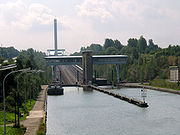
Ronquières inclined plane
Encyclopedia

Canal inclined plane
An inclined plane is a system used on some canals for raising boats between different water levels. Boats may be conveyed afloat, in caissons, or may be carried in cradles or slings. It can be considered as a specialised type of cable railway....
on the Brussels-Charleroi Canal
Brussels-Charleroi Canal
The Brussels–Charleroi Canal, also known as the Charleroi Canal amongst other similar names, is an important canal in Belgium. The canal is quite large, with a Class IV Freycinet gauge, and its Wallonian portion is long. It runs from Charleroi in the south to Brussels in the north...
in the province of Hainaut in Wallonia that opened in April 1968 after a six year construction period. It is located in the municipality of Braine-le-Comte
Braine-le-Comte
Braine-le-Comte is a Walloon municipality located in the Belgian province of Hainaut.On January 1, 2006, Braine-le-Comte had a total population of 20,305...
, and takes its name from the nearby village of Ronquières
Ronquières
Ronquières Ronquières Ronquières (Ronkière in WalloonIt is best known as the location of the Ronquières inclined plane on the Brussels-Charleroi Canal. The lower end of the inclined plane is just a few hundred metres from the centre of the village....
.
The purpose of the construction was to reduce the delays imposed by the fourteen locks
Lock (water transport)
A lock is a device for raising and lowering boats between stretches of water of different levels on river and canal waterways. The distinguishing feature of a lock is a fixed chamber in which the water level can be varied; whereas in a caisson lock, a boat lift, or on a canal inclined plane, it is...
(already reduced from sixteen in the nineteenth century) which had hitherto been needed for the canal to follow the local topography.
Description
The Ronquières Inclined Plane has a length of 1,432 m and lifts boats through 67.73 m vertically. It consists of two large caissons mounted on rails. Each caisson measures 91 m long by 12 m wide and has a water depth between 3 and 3.70 m. It can carry one boat of 1,350 tonnes or many smaller boats within the same limits.Each caisson has a 5,200 tonne counterweight running in the trough below the rails, which permits the caisson to be moved independently of the other. Each caisson is pulled by 8 cables (each of which is 1480m long) wound by winches located at the top end of the inclined plane.
Each caisson can be moved between the two canal levels at a speed of 1.2 m/s, taking about 22 minutes.
It takes 50 minutes in total to pass through the 1800 m of the entire structure, including the raised canal bridge at the top end.
See also
- Ronquières, the non official site
- Strépy-Thieu boat liftStrépy-Thieu boat liftThe Strépy-Thieu boat lift lies on a branch of the Canal du Centre in the municipality of Le Rœulx, Hainaut, Belgium. With a height difference of between the upstream and downstream reaches, it is the tallest boat lift in the world, and will remain so until the Three Gorges dam boat lift in...
- Article on the French-language Wikipedia from which this article was translated
- Falkirk WheelFalkirk WheelThe Falkirk Wheel is a rotating boat lift located in Scotland, UK,connecting the Forth and Clyde Canal with the Union Canal, opened in 2002. It is named after the nearby town of Falkirk which is in central Scotland...
- Official Site — with photos

